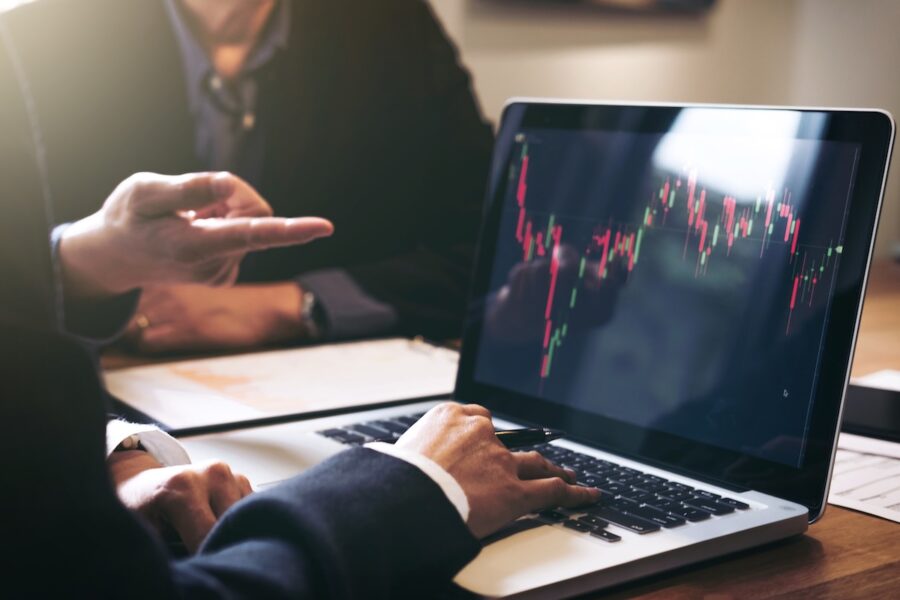Introduction
The Forex market, the short form of the foreign exchange market, has been omnipresent since the turn of Mesopotamian civilization.

Over the years, the market has taken a dynamic turn, becoming a financial stronghold for banks, financial institutions, and traders to buy and sell currencies. For more, you can visit https://roboforex.com/es/ to learn more about the market and its whereabouts.
Moreover, from being a normal barter system, today, AI and blockchain technology are adding flair to the market. The development is remarkable. It forecasts the economic strength of one state in regard to the other. It determines trade relations and geopolitical tension in the world. Moreover, it controls the global economy and possesses the power of building and ruining a state.
Therefore, if you seek to invest in the forex market, you should learn about its history and how the present echoes the stories of the past. The whole evolution is key for the smooth functioning of the state. Consequently, new traders must know how each currency came and contributed to the development of the forex market.
Now, from banks to individual traders, everyone can contribute to the forex market and drive it forward. Hence, in this section, we will excavate the past stories of the forex market as compared to today. That way, you can understand the technological development and surge for new ones to come and disrupt the market altogether.
Early roots of forex market to present day
Amsterdam was the city where everything was about the forex market. Still, in its nuptial stage, the market began about 500 years ago. Since then, the market has been innovating and evolving to bring more and more institutions and individual traders into the market. The innovative idea of creating a foreign exchange marketplace helped states stabilize their economy and bring peace to their land.
Later, the marketplace developed and became what we today see as the forex market. Here are a few key eras that kick-started the growth of the forex market:
Early Beginnings
As per popular belief, the whole currency exchange began in Babylon. The period was marked by a barter system, where people used to exchange different items for goods and services. That laid the foundation for the forex market and brought more and more institutions to get engaged with the market. This illustrates the ages of financial transactions that led to the establishment of the forex market.
Moreover, in ancient times, money changers played a key role in the currency exchanged. Their presence in the city halls and Temple’s court highlighted the presence of different currencies globally. In other words, they were the precursors of modern traders and brokers who played key roles in today’s market and established the rules and the order.
Also, coin exchange occurred in ancient Egypt around 259 BC. It played a key role in establishing trade routes for different countries or kingdoms. At the time, they saw gold and silver as a medium to exchange goods and services. Later, similar dynamics were replaced by the paper economy, but they followed similar principles in the old times.
The 20th Century Era
This era continued between 1875 and 1913 when gold became an important aspect of foreign exchange. Even though there was an existence of a paper economy, several countries adopted the gold standard in the 1800s to enhance the strength of their economies. Later, the era foresaw trouble due to the World Wars and collapsed, giving way to the Bretton Woods System as the order of the day.
The Bretton Wood System came into existence after World War II, with the intention of creating a stable foreign exchange market. The system fixed all currencies to US dollars and kept the gold standard with it. Later, the system formed the modern forex market, where you can see an adjusted pegged foreign exchange market. Also, during this era, Pound Sterling emerged as a currency and became a powerhouse in the forex market. Later, London became the center of the global forex market, and Sterling became a significant player in the forex market.
Later, in 1971, President Nixon removed the gold standard from the forex process and changed the course of the forex market. That way, the simple economics of supply and demand determined the fate of currencies and adjusted their values. However, in the 1980s, the Plaza Accord came, and it changed the forex’s history. The accord highlighted the imbalance in the currency values and overvaluation of US dollars. This marked the decline of US valuation in the forex market and adjusted the whole forex market.
The 1990s and the Forex Market
The advent of Euros in 1999 changed the whole forex market. The unified euro and its acceptance by the European countries stabilized the European economy and also streamlined the whole trade investment. Later, this development expanded the forex market and enhanced the acceptance of euros as a part of global trade and relations.
After the introduction of the euros in the forex market, the market was fixed, and transparency was achieved. The dealers now knew about the inventory risks and fixed inventory imbalance, which was prevalent with the US dollars. Hence, it became easier for the dealer to get their inventory cost back quickly and do their trade properly.
Moreover, it decentralized the whole market and introduced other currencies to take part in the forex market and mark trade routes. Furthermore, it helped European countries trade with other countries using Euros and build relationships with other states. That way, their trade relations grew and influenced the geopolitical tension with Asian and Middle-East countries.
Turn of the 2000s and Forex Market
The turn of the new century was marked by the rise of the internet, which changed the outcome of the forex market. Now people no longer have to visit the market, instead, they can trade from their computer screens. This provided a serious opportunity for the banks to enter the domain and take control of the market. Their aim was to bridge the gap between the individuals and the forex market and make the market a house name.
Today, especially with the surge of the internet and the invention of smartphones, you can easily access the forex market. You can open an account at your convenience and control the dynamics of your payment. Furthermore, you can trade 24\5 and trade in time zones to diversify your trading portfolio. Hence, it opened doors for every individual to enter the domain with your trading strategy.
Moreover, digital currencies are getting popular and are slowly entering the market. In modern-day, banks trade in digital currencies and ask individuals to do the same to maintain transparency in the trading and keep the records open to all. Also, with AI and IoT technology, the accuracy of each investment has improved significantly. It also comes with an algorithm and blockchain technology, which keeps the transactions safe and secured.
Influence of Central Banks in The Forex Market
In modern times, central banks control the forex market. They set the price for the foreign exchange and ensure the state can trade with that fixed amount. That way, they reflect the real value equilibrium of the market and how it connects with the broader economy and affects the global landscape. The central banks intervene if the exchange rate collapses and maintain confidence in the market. Thus, you see a market where people can trade freely and reap their rewards on the investments they make.
Here are a few ways central banks influence the forex market –
Fixe The Currency Rates
Central banks play a crucial role in fixing the currency rates in the forex market. The rates are indicators of the market trends, which signifies the currency’s value in the present landscape. They base the value of the currency on supply and demand, which helps them to calculate the value of others. Hence, the rate fixed in the forex market influences the decision-making process of other banks, financial institutions, and individual traders.
Currency Stabilization in the Forex Market
Another thing that the forex market does is stabilize the currency prices in the forex market. If the rate of the currency falls or exceeds the normal state, and eventually harms the functioning of the forex market. The central intervenes and fixes the issue to ensure that the market is in order and works in perfect order. One such instance happened when the European Exchange Rate Mechanism broke, and the central bank fixed the issue to maintain confidence in the market. That way, they keep the forex market functioning like a well-oiled machine.
Challenges central bank faces in the forex market
The grass is never greener on the other side. Even though they continuously look to stabilize the whole forex market. However, it is a daunting task, as the market is huge, and highly volatile, which makes it difficult for the central bank to intervene in the process and fix the issue. Moreover, the sensitive nature of the forex market overpowers the interventions of central banks and pours water into a decisive strategy.
Thus, the experts suggest traders and central banks remain vigilant in the forex market and pounce on every volatile activity that happens in the market. That way, they can predict the market and keep the market under the tab and not lose grip over it. In addition, central banks also need to focus on other things like political tension, and economic policies, which further ushers the hypersensitive nature of the forex market.
Future of the forex market
In the end, if we look at the forex market from the modern landscape, it has huge potential going forward, especially with the advent of modern technology like IoT and AI. That way, it has become accessible to various individual traders. AI and IoT provide real-time data, which helps them to analyze the market. Hence, it influences traders’ decision-making process and enables them to make the best trade.
Moreover, if we dig the market deeper, you will see great flexibility and adaptability, which will bring young people into the fold. More so, you will see college students participating in the market and buying and selling currency pairs. With constant evolution, the forex market will move from newspaper columns to household discussions, and everyone will invest in them.
Also, various education courses and institutions provide various courses to help new traders improve their trading skills. That way, traders can position themselves to take maximum benefit from the market and diversify their trading portfolio. This will further help them build a financial asset, which will give them better security and safety.
You can read the article and find out about the transition the forex market went through, from barter systems to blockchain technology, making the market accessible to individuals rather than just banks and institutions.
FAQs
Here are a few frequently asked questions –
What is the most successful strategy in forex trading?
Here are a few of the most successful strategies in forex trading –
- Scalping Strategy
- Candlestick Strategy
- Moving Average Strategy
What is the history of FX trading?
The history of forex trading began in the Babylon period, when the currency exchange process started, and people used to trade in the form of barter system. Later, with the evolution of the forex market, it became the biggest and most liquid market in the world. From Bretton Woods to the use of technology, the forex market has come a long way and is still evolving.
Is there a 100% forex strategy?
There is no fixed strategy for the forex market that will give you the best results. This is because various factors and geopolitical events motivate market volatility. Hence, the market is unpredictable, and you see indifferent currency prices in a matter of minutes.
What is the secret behind forex trading?
The trading attitude is the key factor behind big wins in the forex market. For traders, it is necessary to wait for the right opportunity to enter and exit the forex market. If you choose to rush, in high probability, you will put your financial assets at risk.



